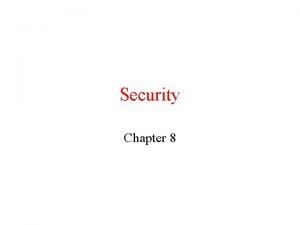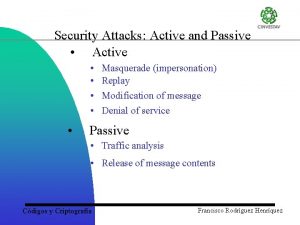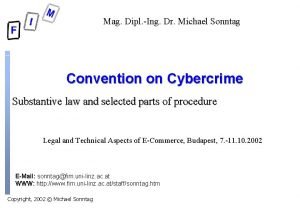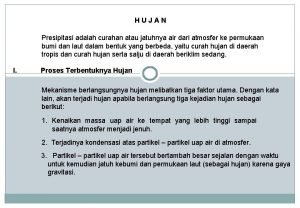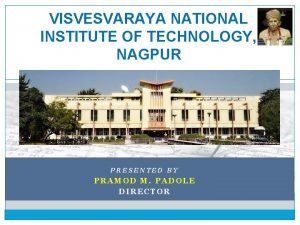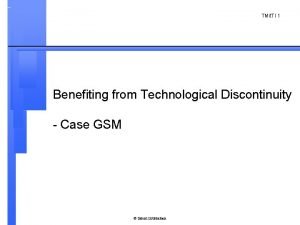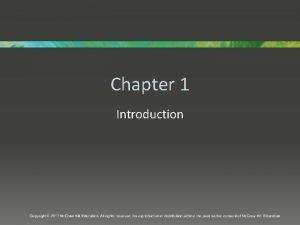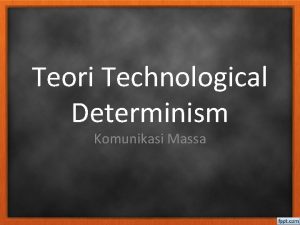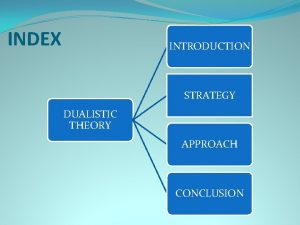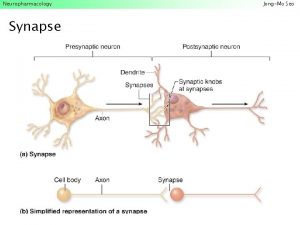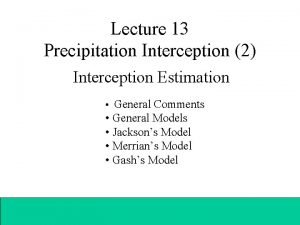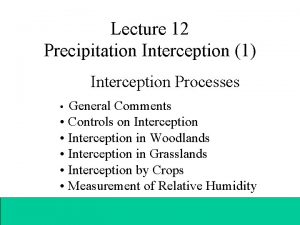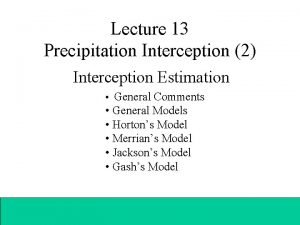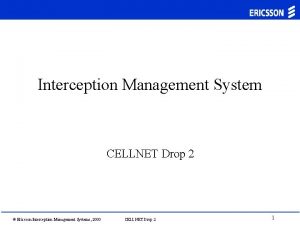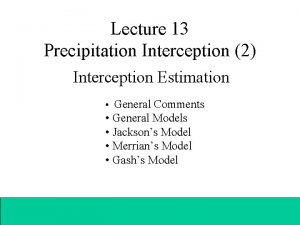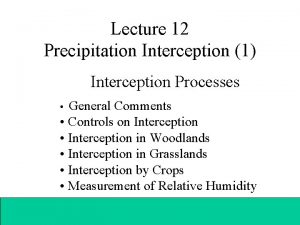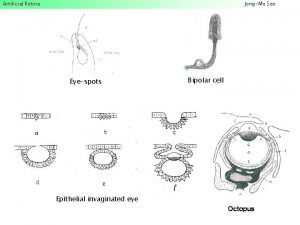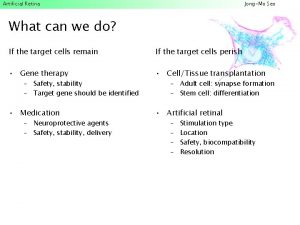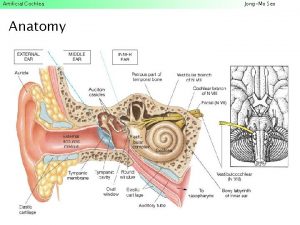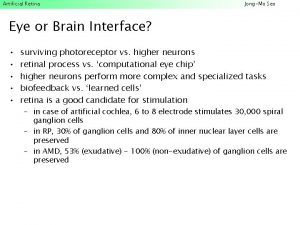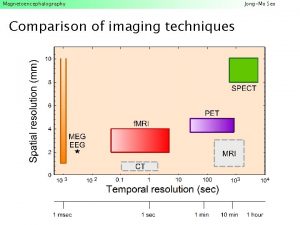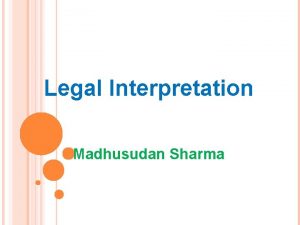Interception and Interpretation JongMo Seo Technological evolution of































- Slides: 31

Interception and Interpretation Jong-Mo Seo Technological evolution of BCI • 1970 s: research algorithms to reconstruct movements from motor cortex neurons • 1980 s: Johns Hopkins researchers found a mathematical relationship between electrical responses of single motor-cortex neurons in rhesus macaque monkeys and the direction that monkeys moved their arms (based on a cosine function). • 1990 s: Several groups able to capture complex brain motor centre signals using recordings from neurons and use these to control external devices • The common thread throughout the research is the remarkable cortical plasticity of the brain, which often adapts to BCIs

Interception and Interpretation Jong-Mo Seo Practical Elements • Signal acquisition: the BCI system's recorded + digitised brain signal input. • Signal processing: conversion of raw information into device command – Feature extraction = the determination of a meaningful change in signal Feature translation = the conversion of that signal alteration to a device command. – Statistical analysis on the basis of the probability function that an electrophysiological event correlates with a given cognitive or motor task. • Device output: the overt command or control functions produced. – word processing, communication, wheel chair, prosthetic limb. – new output channel, therefore must have feedback to improve how they alter their electro physiological signal. • Operating protocol: the manner in which the system is turned on/off.

Interception and Interpretation Jong-Mo Seo Neurosurgical issues • • • Safety Durability/Reliability: scar, removal and re-implantation Consistency, Useful complexity (DOF) Suitability Speed and accuracy Efficacy: Technical vs. Practical

Interception and Interpretation Jong-Mo Seo EEG-based BCI • P 300 evoked potentials – brain's response to infrequent or significant stimuli from its response to routine stimuli. • Sensorimotor Cortex Rhythms – Movement or preparation for movement is typically accompanied by a decrease in µ (8– 12 Hz) and beta (18– 26 Hz) activity over sensorimotor cortex – People, including those with ALS or SCI have learned to control µ or beta amplitudes in the absence of movement or sensation • susceptible to external forces (i. e. , electrode movement) and contamination • less fidelity and spatial specificity and a limited frequency detection (<40 Hz), resulting in prolonged user training for higher levels of control. • Spatial and frequency limitations prohibits complexity of movements supported by EEG

Interception and Interpretation Jong-Mo Seo Single unit-based BCI • Best signal for BCI control has been achieved with multiple, single-unit action potentials recorded in parallel directly from cerebral cortex, in terms of accuracy, speed and DOF than single unit data. • Obtaining long-term stability of single unit recordings has proven difficult - Only provide a year of BCI control • Require insertion of a recording electrode into the brain parenchyma • Prone to scarring, implanted in eloquent regions of cortex

Interception and Interpretation Simultaneously recorded intracellular and extracellular signals Jong-Mo Seo

Interception and Interpretation Jong-Mo Seo Spatial dependence of spike waveform

Interception and Interpretation Chronic recording electronics Jong-Mo Seo

Interception and Interpretation Jong-Mo Seo How do you know you have a single unit? • Spike train autocorrelation • Always verify refractory period relative to long-time asymptote of autocorrelation function • Latency Variability Analysis

Interception and Interpretation Antidromic Spike Collision Jong-Mo Seo

Interception and Interpretation Jong-Mo Seo Voltage (A/D Levels) Multiple neural signals Voltage (A/D Levels) Time (sec) 3 msec

Interception and Interpretation Spike sorting Jong-Mo Seo Region from previous slide Raw Data Spike Detector Neuron #1 Spikes Neuron #2 Spikes Time (sec)

Interception and Interpretation Jong-Mo Seo The ‘graduate student’ algorithm Voltage (A/D Levels) Raw Data Threshold detector at 3 2 Time (sec) Interspike Interval Histogram Width (msec) Voltage (A/D Levels) Spike Height vs. Width Plot # of Intervals Candidate Waveforms Time (msec) Height (A/D Levels)

Interception and Interpretation Jong-Mo Seo General framework Locate Spikes Preprocess Waveforms Density Estimation Spike Classification Quality Measures

Interception and Interpretation Principal Component Analysis • Create “feature vector” for each spike • “Feature space” Jong-Mo Seo

Interception and Interpretation Jong-Mo Seo Post-Stimulus Time Histogram (PSTH) 40 µV 200 ms

Interception and Interpretation Semi-automatic Clustering Jong-Mo Seo

Interception and Interpretation Jong-Mo Seo Electrocorticogram-based system • Electrocorticogram (Eco. G) measures electrical activity of the brain taken from beneath the skull (subdural or epidural) • Gamma rhythms as well as µ and beta rhythms are prominent in ECo. G during movements • higher spatial resolution, better signal-to-noise ratio, wider frequency range, and lesser training requirements than scalprecorded EEG

Interception and Interpretation Jong-Mo Seo

Interception and Interpretation Jong-Mo Seo

Interception and Interpretation Electric current dipole fields Jong-Mo Seo

Interception and Interpretation Jong-Mo Seo Power spectrum handling & auto correlation function

Interception and Interpretation Jong-Mo Seo Artifact detection in EEG EOG EMG

Interception and Interpretation Jong-Mo Seo Stimulation mapping to locate cortical areas

Interception and Interpretation Jong-Mo Seo Electromyography • Indicator for muscle activation/deactivation • Electrode Categories – Inserted • Fine-wire (Intra-muscular) • Needle – Surface

Interception and Interpretation Jong-Mo Seo Fine wire electrode vs. surface electrode • Pros • Cons – – Extremely sensitive Record single muscle activity Access to deep musculature Little cross-talk concern – Extremely sensitive – Requires medical personnel, certification – Repositioning nearly impossible – Detection area may not be representative of entire muscle – Quick, easy to apply – No medical supervision, required certification – Minimal discomfort – Generally used only for superficial muscles – Cross-talk concerns – No standard electrode placement – May affect movement patterns of subject – Limitations with recording dynamic muscle activity

Interception and Interpretation Jong-Mo Seo Characteristics of EMG signal and noise • Signal – Amplitude range: 0– 10 m. V (+5 to -5) prior to amplification – Usable energy: Range of 0 - 500 Hz – Dominant energy: 50 – 150 Hz • Noise – Inherent noise in electronics equipment: 0 – thousands Hz • Cannot be eliminated • Reduced by using high quality components – Ambient noise: e. g. 60 Hz • Radio transmission, electrical wires, fluorescent lights • Essentially impossible to avoid • Amplitude: 1 – 3 x EMG signal – Motion artifact: 0 – 20 Hz • Electrode/skin interface, electrode cable • Reducible by proper circuitry and set-up – Inherent instability of signal • Amplitude is somewhat random in nature • Frequency range of 0 – 20 Hz is especially unstable > removal

Interception and Interpretation Jong-Mo Seo Maximizing quality of EMG signal • Signal-to-noise ratio – Highest amount of information from EMG signal as possible – Minimum amount of noise contamination • As minimal distortion of EMG signal as possible – No unnecessary filtering – No distortion of signal peaks – No notch filters recommended, e. g. 60 Hz • Differential amplification – Reduces electromagnetic radiation noise – Dual electrodes • Electrode stability – Time for chemical reaction to stabilize – Important factors: electrode movement, perspiration, humidity changes • Improved quality of electrodes – Less need for skin abrasion, hair removal

Interception and Interpretation Jong-Mo Seo

Interception and Interpretation Nerve conduction measurement • motor nerve conduction study, MNCS) • sensory nerve conduction study, SNCS) Jong-Mo Seo

Interception and Interpretation Jong-Mo Seo
 Jongmo
Jongmo Interruption in network security
Interruption in network security Poor network policy
Poor network policy Evolution of computer architecture
Evolution of computer architecture Sms interception hack
Sms interception hack Interception attack
Interception attack Dr michael sonntag
Dr michael sonntag Interception hydrology
Interception hydrology Interception is an attack on
Interception is an attack on Lawful interception architecture
Lawful interception architecture Hujan
Hujan How does interpretation b differ from interpretation a
How does interpretation b differ from interpretation a Technology gap model
Technology gap model Technological design and scientific investigation
Technological design and scientific investigation Visvesvaraya technological university nagpur
Visvesvaraya technological university nagpur Technology discontinuity
Technology discontinuity Technological risk definition
Technological risk definition What is technological modelling
What is technological modelling Technological leader
Technological leader Technological design
Technological design Pest political economic social technological
Pest political economic social technological Institute for prospective technological studies
Institute for prospective technological studies Convergence of technology examples
Convergence of technology examples Importance of technological innovation
Importance of technological innovation What is business
What is business Teori technological determinism
Teori technological determinism Technological dualism
Technological dualism Internal factors affecting tesco
Internal factors affecting tesco Technological forecasting
Technological forecasting Technological dualism
Technological dualism Five things we need to know about technological change
Five things we need to know about technological change Pama technological support
Pama technological support

